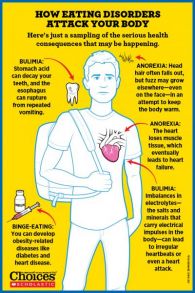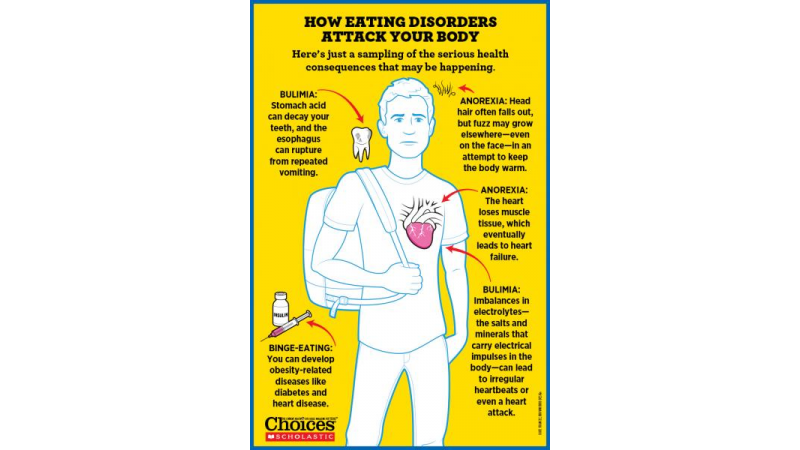 This week is National Eating Disorders Awareness Week, and today we have a guest post from Kim Tranell, editor of Choices, Scholastic’s health and life skills magazine for teens. She’s sharing what every parent and teacher needs to know about these devastating illnesses.
This week is National Eating Disorders Awareness Week, and today we have a guest post from Kim Tranell, editor of Choices, Scholastic’s health and life skills magazine for teens. She’s sharing what every parent and teacher needs to know about these devastating illnesses.
In our March issue, you’ll find what is perhaps the very first Choices story pitched by my dad. A passionate Penn State football fan, he texted me a link to an article about the team’s kicker, who was in treatment for an eating disorder: "Great story for Choices," he wrote (probably from his favorite power blue arm-chair). I couldn’t have agreed more. Stunned fans were already posting in online forums: Him? An eating disorder? He’s big. He’s a guy. It just doesn’t make sense…
Oh, but it does! And while they scratched their heads, I started planning a very necessary and clearly overdue article on the stereotypes and stigmas that prevent many teens from recognizing—and seeking help for—these complex diseases. They’re the same factors that stop the adults in their lives from being there to help too. I strongly urge you to read the entire piece, which is anchored by the incredibly introspective testimonies of three brave teen survivors. But if you only have a few minutes, we’ve gathered some key takeaways below. Please share this myth-busting primer with friends and followers in honor of National Eating Disorders Awareness Week.
Myth #1: Boys don’t get eating disorders.
Our culture has conditioned us to believe that eating disorders are diseases that strike only young, white women. But in fact, up to one-third of all eating disorder sufferers are male, according to a study by the Centers for Disease Control. Most males just don’t understand they’re at risk because their stories aren’t told. It took Joey Julius, the Penn State kicker, 11 years to seek treatment for the debilitating mental and physical health effects of his binge-eating disorder.
Myth #2: Only white girls get eating disorders.
Research shows that people of every race and ethnicity suffer from eating disorders, yet the stigma (and lack of eating disorders education) in certain communities can be strong. For instance, when Ayanna, one of the brave survivors featured in our March story, approached her well-meaning parents about her problems, they told her, “Black people don’t get eating disorders.” It took her several months before she worked up the courage to approach them again.
Myth #3: Eating disorders always make you dangerously skinny.
Often, the discourse surrounding eating disorders focuses solely on emaciated individuals with a diagnosis of anorexia, but the people who suffer from these complex illnesses may be underweight, normal weight, or overweight. They may even be athletes who appear toned and fit. The bottom line: You cannot define someone’s health by their appearance, but you can pay attention to drastic changes to their weight in any direction—as well as their attitudes and behaviors about food. (Check out the Choices piece for a checklist that can help you spot common warning signs.)
Myth #4: Eating disorders are a choice.
This one isn’t just wrong—it’s insulting. Eating disorders are complex medical and psychiatric illnesses rooted in both biology (your genes might make you more susceptible) and environment (influences like illness, bullying, and other stressors). Several decades of research also indicates that they are more likely to occur with other mental illnesses, like depression and social anxiety disorder.
Please share this post as a reminder that it isn’t just time to talk about eating disorders–it’s time to change the entire conversation. Educators: Visit the Choices Ideabook blog, where we’ve compiled a list of our fantastic resources for teaching this story. There you’ll find a link to a video, worksheets, teaching tips, and more.
Choices



